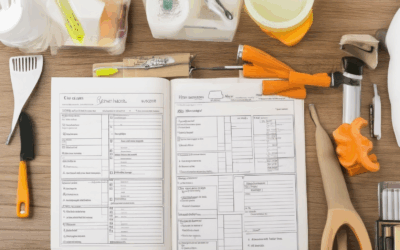Homeownership comes with its fair share of challenges, especially when it comes to handling repairs around the house. From fixing leaky pipes to addressing electrical issues, many homeowners feel overwhelmed by the sheer number of tasks they need to manage. However, mastering the basics of home repair can save both time and money in the long run. This comprehensive guide offers a wealth of information tailored for homeowners looking to gain confidence and skills in tackling various DIY projects. Whether you’re dealing with minor fixes or more complex repairs, this guide serves as your go-to resource for learning the ropes of home maintenance. By equipping yourself with the right tools and knowledge, you can handle repairs with ease and ensure your home stays in great shape. Let’s dive into the essential tools, tips, and strategies that every homeowner should know, providing you with the tools to take control of your home repairs.

How to Learn Basic Home Repair
To master basic home repair, follow these organized steps:
- Understand the Basics : Start by familiarizing yourself with common home systems like plumbing, electrical work, and HVAC. Knowing the fundamentals will give you a foundation for tackling repairs.
- Gather Essential Tools : Invest in basic tools such as a screwdriver set, wrenches, pliers, a multi-meter, and a pipe wrench. These tools are essential for most small repairs.
- Learn Through Videos : Platforms like YouTube offer detailed tutorials for various home repairs. Watch videos to gain practical insights and pacing yourself.
- Get Hands-On Practice : Begin with simple tasks like fixing a leaky faucet or changing a light bulb. As you gain confidence, take on more complex projects.
- Stay Informed : Regularly read blogs or follow DIY communities like DIYHacks to stay updated on techniques and safety guidelines.
- Seek Professional Help When Needed : For major issues or repairs you’re unsure about, consult professionals to avoid further damage.
By following these steps, you’ll build the skills needed to handle basic home repairs confidently. Remember, safety is paramount, and always prioritize learning from reliable sources like Fix It Club and Tools Of Man .
For more guidance, explore our comprehensive guide on Home Maintenance to enhance your DIY expertise.
What Repair Manuals Do Mechanics Use?
Mechanics commonly use repair manuals like Chilton , Haynes , Mitchell , and Bosch . These manuals provide detailed, step-by-step instructions tailored to specific vehicle makes and models, making them invaluable for diagnosing and fixing issues effectively.
Chilton manuals are renowned for their comprehensive coverage, suitable for mechanics with varying levels of expertise. They offer clear, concise guidance for routine maintenance and complex repairs across numerous car, truck, and SUV models.
Haynes publications are equally respected for their thoroughness and ease of understanding. They cater to a broad range of vehicles and are often favored for their practicality and reliability.
Mitchell and Bosch manuals are particularly valued for their advanced diagnostic information and technical details. Mechanics rely on these resources for troubleshooting and resolving intricate issues, ensuring precision and efficiency in their work.
These manuals are preferred due to their accuracy, completeness, and regular updates, ensuring mechanics always have access to the latest information. Many are now available online, offering added convenience for modern users.

Best Home Repair Books
When it comes to home repair, having the right resources can make all the difference. Here are some of the top-rated home repair books that provide comprehensive guidance for homeowners and DIY enthusiasts:
- The Complete Home Improvement Encyclopedia by Marvin Thompson Jr. This book is a go-to resource for homeowners looking to tackle a variety of home repair projects. It covers everything from basic plumbing and electrical work to more complex renovations, offering step-by-step instructions and professional advice. Available on Amazon
- Fix-It Yourself: Home Repair Made Easy by Lance Walheim. Perfect for beginners, this book breaks down home repairs into simple, manageable tasks. It includes illustrations, diagrams, and clear instructions for common fixes around the house, from fixing leaky pipes to repairing appliances. Available on Amazon
- Home Repair & Improvement (For Dummies) by Larry Williams and Monica Suter. Written in a friendly and approachable manner, this book is ideal for anyone who wants to learn the basics of home repair without feeling overwhelmed. It covers essential tools, techniques, and safety tips for various home projects. Available on Amazon
- DIY Home Repairs: A Step-by-Step Guide by Chris Deziel. Targeted toward experienced DIYers, this book delves deep into advanced home repair techniques. It includes detailed guides for projects like installing new flooring, updating electrical systems, and constructing custom cabinetry. Available on Amazon
These books offer a mix of practical advice, visual guides, and real-life examples to help you confidently tackle home repairs. Whether you’re a seasoned pro or a newcomer to DIY projects, there’s something here for everyone.

Basic Structural Repairs
Structural repairs are essential to maintain the integrity and safety of your home. Here are some common types of structural repairs that every homeowner should be aware of:
Wall Repairs
- Drywall patching and sealing
- Crack repairs in both interior and exterior walls
- Water damage restoration
- Termite damage mitigation
- Window frame adjustments
Floor Repairs
- Subflooring replacement or repair
- Tile or hardwood flooring installation
- Creaky floorboards assessment and fixing
- Underlayment issues resolution
- Water damage on floors
Roof Repairs
- Gutter cleaning and maintenance
- Sagging roof correction
- Asphalt shingle replacement
- Flashing repair
- Leak detection and sealing
Window Repairs
- Window frame repair
- Double-glazed window replacement
- Weatherstripping adjustment
- Window sill repair
- Lock and handle replacement
Door Repairs
- Doorframe repair
- Hinge adjustment
- Threshold repair
- Lock replacement
- Weatherstripping adjustment
Foundation Repairs
- Crack sealing
- Concrete spalling repair
- Foundation waterproofing
- Basement wall repair
- Drainage system maintenance
Signs that indicate the need for structural repairs include:
- Visible cracks in walls, floors, or foundation
- Deteriorating materials
- Water stains or mold growth
- Unusual sounds or feel in the home
- Uneven surfaces or sagging structures
Regular home inspections and prompt addressing of structural issues can prevent minor problems from escalating into major, costly repairs. For professional assistance, consult trusted contractors or services like Sams Maintenance to ensure your home remains safe and sturdy.
What Are the 3 Examples of Repair?
- Appliance Repair: Fixing broken appliances like refrigerators, washers, and dryers.
- Plumbing Repairs: Addressing leaks, clogs, and pipe damage.
- Electrical Repairs : Installing new wiring, fixing outlets, and resolving short circuits.

What is a General Repair?
A general repair refers to the process of fixing or addressing issues in various systems, structures, or devices within a property. These repairs can range from minor fixes to more extensive overhauls, depending on the scope of the problem. Here’s a breakdown of what general repairs typically involve:
Types of Repairs
General repairs can encompass a variety of tasks, including:
- Minor fixes, such as patching holes in walls or repairing leaky pipes.
- Major overhauls, like replacing faulty appliances or remodeling spaces.
- Emergency repairs, such as fixing burst pipes or addressing electrical malfunctions.
Essential Tools and Materials
To perform general repairs effectively, you’ll likely need:
- Pliers and screwdrivers for tightening loose hardware.
- Duct tape or sealant for temporary fixes.
- Garden tools for outdoor repairs.
- Basic safety gear, such as gloves and goggles.
Steps in the Repair Process
The typical process for a general repair involves:
- Identifying the source of the issue.
- Turning off the relevant systems or utilities to ensure safety.
- Assessing the damage and determining the appropriate course of action.
- Performing the necessary fixes using the right tools and materials.
- Testing the repaired area to confirm it’s functioning properly.
Common Issues and Prevention Tips
Preventing future repair needs is just as important as addressing immediate issues. Some common problems to watch out for include:
- Broken pipes or leaks in plumbing systems.
- Fading or peeling paint on exterior surfaces.
- Worn-out appliances requiring replacement.
- Loose fixtures that may pose safety hazards.
To prevent these issues, consider scheduling regular inspections and maintaining appliances through routine maintenance.
Safety Tips
Always prioritize safety during general repairs. This includes:
- Turning off the power source before working on electrical systems.
- Wearing protective clothing and equipment.
- Clearing away flammable materials from work areas.
Conclusion
General repairs are essential for maintaining the integrity and functionality of your home or property. Whether it’s a quick fix or a significant renovation, addressing issues promptly can save money and extend the lifespan of your belongings. For more detailed guidance on specific repair topics, explore our resources on SamsMaintenance.com .




0 Comments